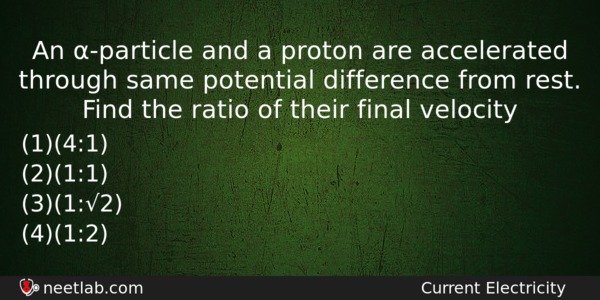| ⇦ | 
| ⇨ |
An α-particle and a proton are accelerated through same potential difference from rest. Find the ratio of their final velocity
Options
(a) (4:1)
(b) (1:1)
(c) (1:√2)
(d) (1:2)
Correct Answer:
(1:√2)
Explanation:
When a charged particle of charge q and mass m is accelerated from rest through a potential difference V.
.·. Gain in kinetic energy = Loss in potential energy
(1/2) mv² – (1/2) m(0)² = qV or (1/2) mv² = qV or v = √(2qV / m)
For proton, v(p) = √[2eV / m(p)] = √[2eV / m] —–(i)
where m is the mass in atomic mass unit
For α-particle v(α) = √[2(2e)V / m(α)]
= √[2(2e)V / 4m] = (1/√2) v(p)
Therefore, v(α) / v(p) = 1/√2
Related Questions: - A radio isotope X with a half life 1.4 x 10⁹ years decays to Y which is stable
- If L and C denote inductance and capacitance,then the dimensions of L-C are
- The dimensional formula of Plancks’s constant and angular momentum are
- The electric current in AC circuit is given by the relation i-3 sinωt+4 cos ωt.
- Zenor diode is used for
Topics: Current Electricity
(136)
Subject: Physics
(2479)
Important MCQs Based on Medical Entrance Examinations To Improve Your NEET Score
- A radio isotope X with a half life 1.4 x 10⁹ years decays to Y which is stable
- If L and C denote inductance and capacitance,then the dimensions of L-C are
- The dimensional formula of Plancks’s constant and angular momentum are
- The electric current in AC circuit is given by the relation i-3 sinωt+4 cos ωt.
- Zenor diode is used for
Topics: Current Electricity (136)
Subject: Physics (2479)
Important MCQs Based on Medical Entrance Examinations To Improve Your NEET Score
18000+ students are using NEETLab to improve their score. What about you?
Solve Previous Year MCQs, Mock Tests, Topicwise Practice Tests, Identify Weak Topics, Formula Flash cards and much more is available in NEETLab Android App to improve your NEET score.
Share this page with your friends

Leave a Reply